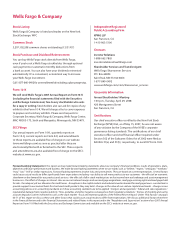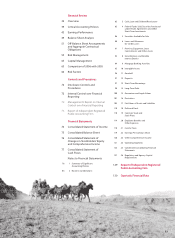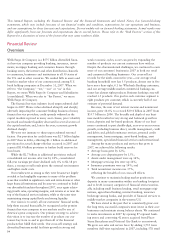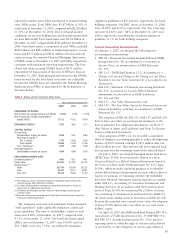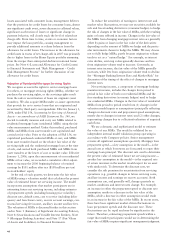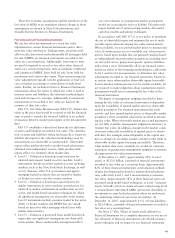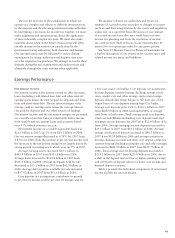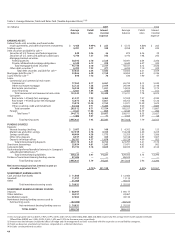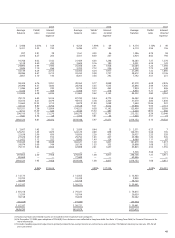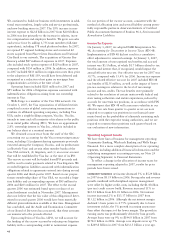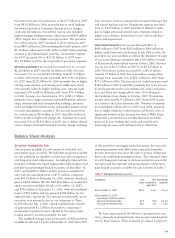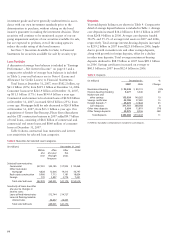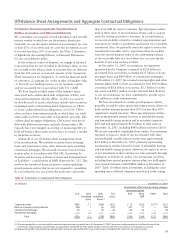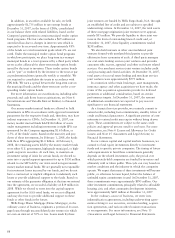Wells Fargo 2007 Annual Report Download - page 45
Download and view the complete annual report
Please find page 45 of the 2007 Wells Fargo annual report below. You can navigate through the pages in the report by either clicking on the pages listed below, or by using the keyword search tool below to find specific information within the annual report.42
Pension Accounting
We account for our defined benefit pension plans using an
actuarial model required by FAS 87, Employers’ Accounting
for Pensions, as amended by FAS 158, Employers’ Accounting
for Defined Benefit Pension and Other Postretirement Plans –
an amendment of FASB Statements No. 87, 88, 106, and
132(R). FAS 158 was issued on September 29, 2006, and
became effective for us on December 31, 2006. FAS 158
requires us to recognize the funded status of our pension and
postretirement benefit plans in our balance sheet. Additionally,
FAS 158 will require us to use a year-end measurement date
beginning in 2008. The adoption of FAS 158 did not change
the amount of net periodic benefit expense recognized in our
income statement.
We use four key variables to calculate our annual pension
cost: size and characteristics of the employee population,
actuarial assumptions, expected long-term rate of return on
plan assets, and discount rate. We describe below the effect
of each of these variables on our pension expense.
SIZE AND CHARACTERISTICS OF THE EMPLOYEE POPULATION
Pension expense is directly related to the number of employees
covered by the plans, and other factors including salary, age
and years of employment.
ACTUARIAL ASSUMPTIONS
To estimate the projected benefit obligation, actuarial
assumptions are required about factors such as the rates of
mortality, turnover, retirement, disability and compensation
increases for our participant population. These demographic
assumptions are reviewed periodically. In general, the range
of assumptions is narrow.
EXPECTED LONG-TERM RATE OF RETURN ON PLAN ASSETS
We determine the expected return on plan assets each year
based on the composition of assets and the expected long-
term rate of return on that portfolio. The expected long-term
rate of return assumption is a long-term assumption and is
not anticipated to change significantly from year to year.
To determine if the expected rate of return is reasonable,
we consider such factors as (1) long-term historical return
experience for major asset class categories (for example,
large cap and small cap domestic equities, international
equities and domestic fixed income), and (2) forward-looking
return expectations for these major asset classes. Our expected
rate of return for 2008 is 8.75%, the same rate used for
2007 and 2006. Differences in each year, if any, between
expected and actual returns are included in our net actuarial
gain or loss amount, which is recognized in other compre-
hensive income. We generally amortize any net actuarial gain
or loss in excess of a 5% corridor (as defined in FAS 87) in
net periodic pension expense calculations over the next five
years. Our average remaining service period is approximately
11 years. See Note 20 (Employee Benefits and Other
Expenses) to Financial Statements for information on funding,
changes in the pension benefit obligation, and plan assets
(including the investment categories, asset allocation and the
fair value).
We use November 30 as the measurement date for our
pension assets and projected benefit obligations. If we were to
assume a 1% increase/decrease in the expected long-term
rate of return, holding the discount rate and other actuarial
assumptions constant, pension expense would decrease/increase
by approximately $54 million. In 2008 we will use December 31
as our measurement date as required under FAS 158.
DISCOUNT RATE
We use a discount rate to determine the present value of our
future benefit obligations. The discount rate reflects the current
rates available on long-term high-quality fixed-income debt
instruments, and is reset annually on the measurement date.
To determine the discount rate, we review in conjunction
with our independent actuary, spot interest rate yield curves
based upon yields from a broad population of high-quality
bonds, adjusted to match the timing and amounts of the
Cash Balance Plan’s expected benefit payments. We used a
discount rate of 6.25% in 2007 and 5.75% in 2006.
If we were to assume a 1% increase in the discount rate,
and keep the expected long-term rate of return and other
actuarial assumptions constant, pension expense would
decrease by approximately $6 million. If we were to assume
a 1% decrease in the discount rate, and keep other assump-
tions constant, pension expense would increase by approxi-
mately $82 million. The decrease in pension expense due to
a 1% increase in discount rate differs from the increase in
pension expense due to a 1% decrease in discount rate due
to the impact of the 5% gain/loss corridor.
Income Taxes
We are subject to the income tax laws of the U.S., its states
and municipalities and those of the foreign jurisdictions in
which we operate. We account for income taxes in accordance
with FAS 109, Accounting for Income Taxes, as interpreted
by FIN 48, Accounting for Uncertainty in Income Taxes. Our
income tax expense consists of two components: current and
deferred. Current income tax expense approximates taxes to
be paid or refunded for the current period and includes
income tax expense related to our uncertain tax positions.
We determine deferred income taxes using the balance sheet
method. Under this method, the net deferred tax asset or
liability is based on the tax effects of the differences between
the book and tax bases of assets and liabilities, and recog-
nized enacted changes in tax rates and laws in the period in
which they occur. Deferred income tax expense results from
changes in deferred tax assets and liabilities between periods.
Deferred tax assets are recognized subject to management’s
judgment that realization is “more likely than not.” Uncertain
tax positions that meet the more likely than not recognition
threshold are measured to determine the amount of benefit
to recognize. An uncertain tax position is measured at the
largest amount of benefit that management believes is greater
than 50% likely of being realized upon settlement. Foreign
taxes paid are generally applied as credits to reduce federal
income taxes payable. We account for interest and penalties
as a component of income tax expense.


